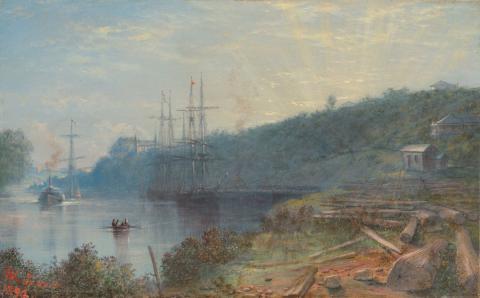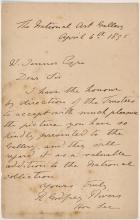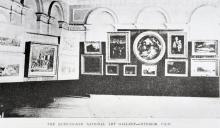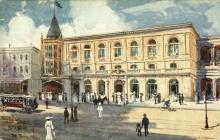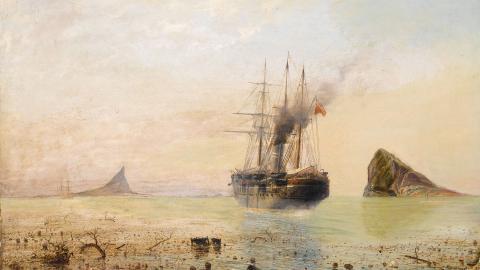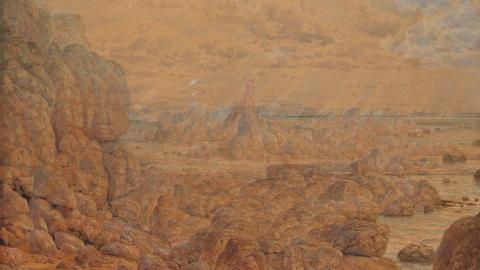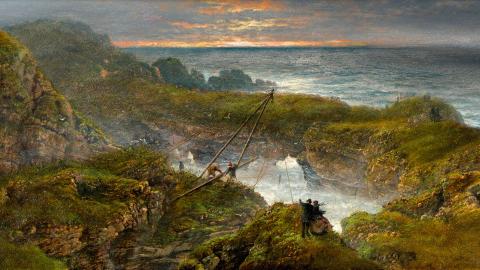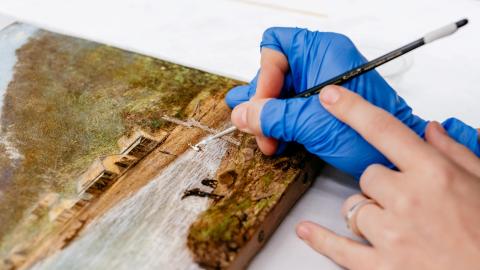Meet Isaac Walter Jenner
In the wealthier Australian colonies, with larger educated classes, the prevailing English ideas of the social mission of art — of its civilising and moral value — were warmly embraced. Brisbane, intent on utilitarian concerns, was slower to accept such notions, and for decades the visual arts were applied with few exceptions to practical ends.
— Gavin Fry and Bronwyn Mahoney1

Isaac Walter Jenner, c.1870s (unknown photographer) / Published in Kaye Mobsby, Henry William Mobsby (1860–1933): ‘…a most valuable officer’, Mount Ommaney, Qld, 2017 / Courtesy: Harold Jenner
Isaac Walter Jenner was born on 8 March 1836 in Surrey, England. In 1854, he joined the Royal Navy, working as a painter maintaining ships’ finishes as well as ‘decorative work and signwriting’2. He retired from the Navy at age 29, settling by the sea in Brighton with his wife, Mary Jenkins, whom he’d married in May of 1860.
In his papers, Jenner wrote that he ‘took to painting shipping and scenes from memory of some of the episodes in my career in the Navy’, many of which were exhibited and sold at the Royal Academies of London and Edinburgh and in galleries across England, including London’s Crystal Palace.3

Isaac Walter Jenner, c.1870s (unknown photographer) / Collection: QAGOMA Research Library
The Jenner family — Walter, Mary and their seven children — left England for Australia in 1883. Their party included HW (Henry William) Mobsby, the fiancé of their eldest daughter, Mary Ellen. In their fundamental 1993 book on Jenner, Fry and Mahoney write:
Despite these sales and exhibitions Jenner’s position in fashionable nineteenth-century Brighton would have been insecure. He was talented but untrained, and not an officer-turned-artist — just a sailor. There is no concrete evidence of his motivation for migration, though tales of wealth and success must have been a factor... An auction in November 1880 of some 50 of Jenner’s works may have been intended to raise funds towards the major cost of moving his large family to Australia.4
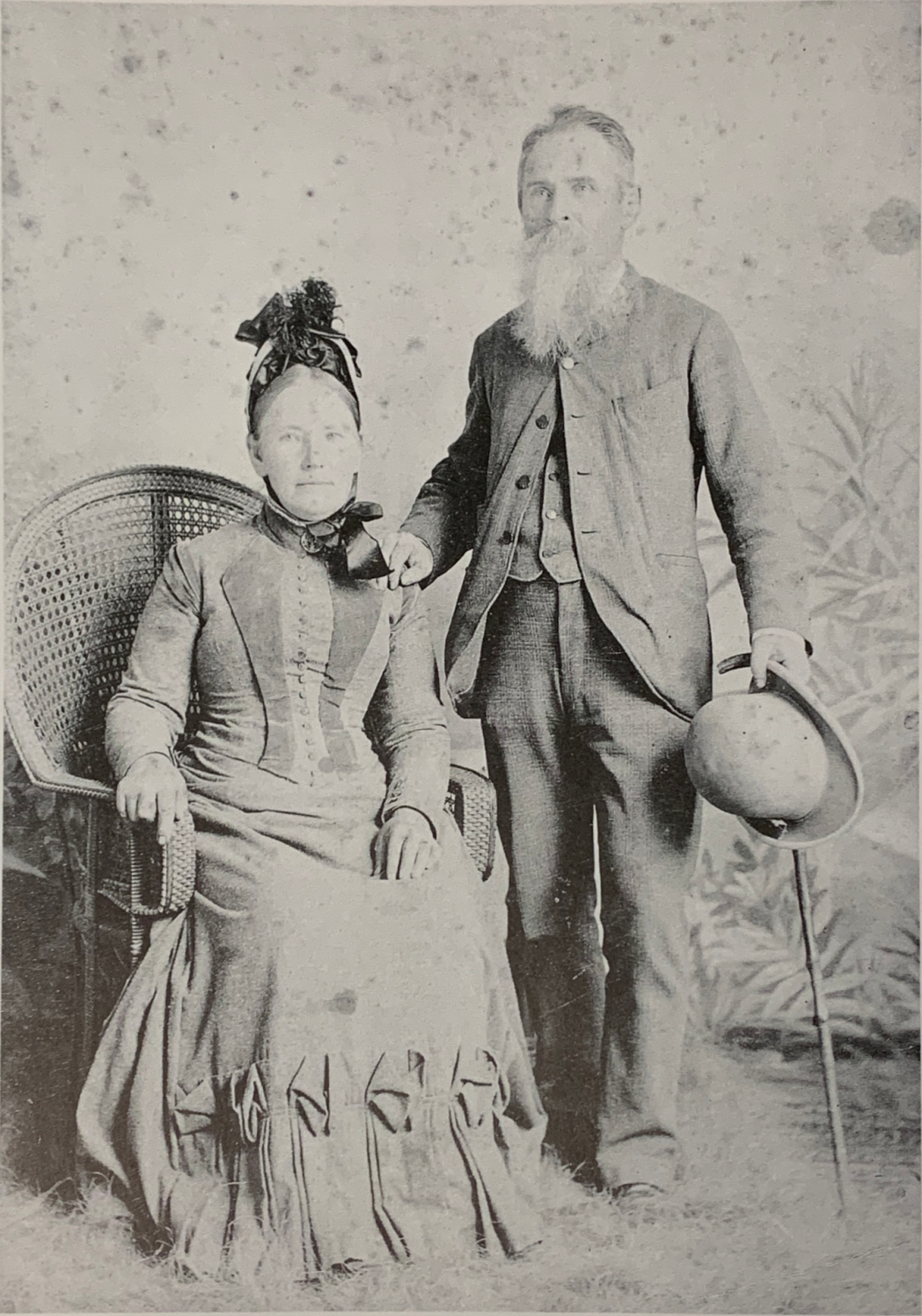
Alex C Wishart Studio, Red Hill (photographer) / Mary and Isaac Walter Jenner, c.1884 / Image courtesy: Gavin Fry and Bronwyn Mahoney
Explore related works
The Jenner family’s first home was on Dornoch Terrace, in the suburb of Highgate Hill, and later settled on Montrose Street in Taringa. Jenner quickly established himself as an artist in Brisbane, first showing work at the Queensland National Agricultural and Industrial Association (QNA) Exhibition in 1884.5 By December 1889, the Queenslander newspaper considered his work ‘so familiar to us as to render a description almost unnecessary’.6
In his own papers, Jenner credits himself as having ‘founded the Queensland Art Society [QAS], which … won’t say die while there is a shot in the locker’.7 Fry and Mahoney describe the ‘almost mythical status’ of the embellished origin story of the QAS, which involves Jenner sheltered under the Grimes and Petty awning — at the corner of Queen and Albert Streets, as seen in the image below — with artists Oscar Friström and LWK Wirth. Together, they despaired at the state of the arts in Queensland and devised the Society. Early QAS records were lost in a fire; however, the club was formalised in 1887. Jenner referred to himself in his papers as ‘the parent of the Society’.8

‘Corner Queen and Albert Street, Brisbane, 1886 (showing Grimes and Petty Clothing/Drapery Store)’ 1886 (unknown photographer) / Courtesy: Queensland University of Technology, Brisbane
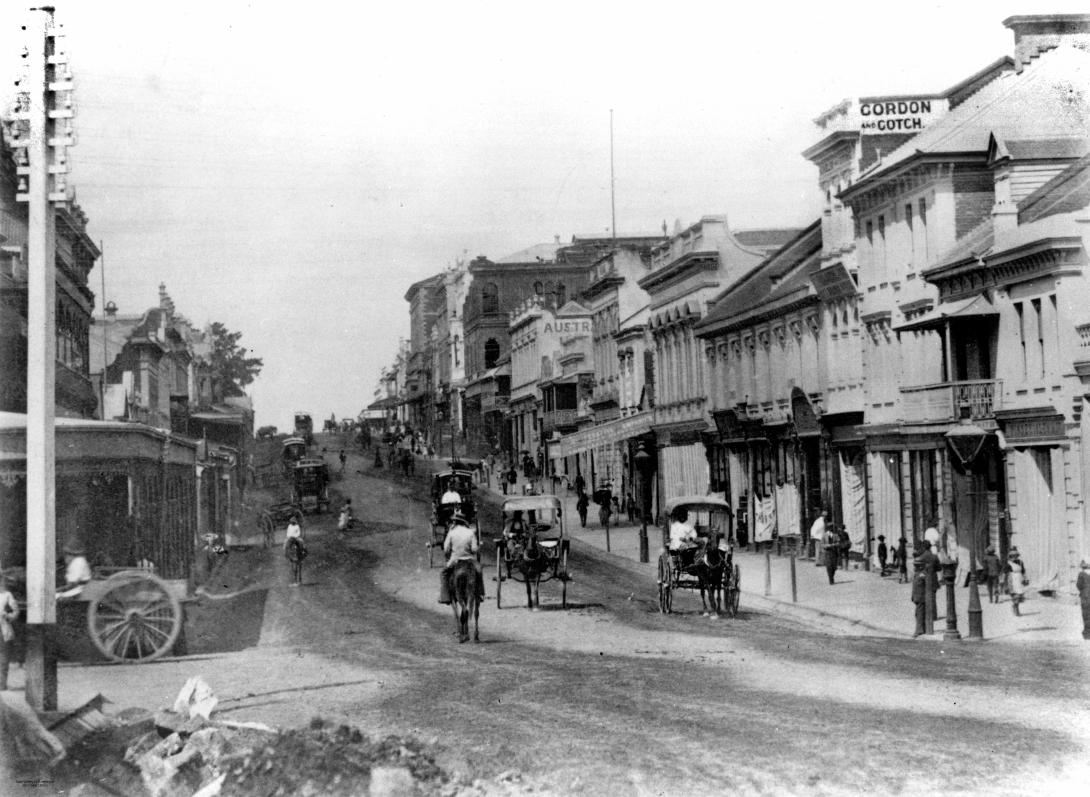
Albert Lomer / Australia active 1862–1900 / Queen Street, from the corner of Edward Street looking south, Brisbane 1883 / Courtesy: John Oxley Library, State Library of Queensland
In 1884, after barely a year in Queensland, Jenner wrote to the Daily Telegraph as part of his campaign for the founding of a public art gallery:
… a building is needed in some part of Brisbane … for pictures … sculpture … a good library, and museum of natural history … The building should be situated, if possible, in the public gardens or park, which might contain the botanical and horticultural gardens, also the zoological gardens, and so make one institution minister to the success of the others.9
Jenner would have to wait another decade for official support for a public gallery; he wrote to a friend of ‘the thick mass of ignorance through which one has to wade in the matter of Art in this country’.10 This attitude brought him into professional conflict with established Brisbane artist and art teacher Joseph Clarke, which escalated into public feud. Of QAS's first exhibition, Clarke wrote:: ‘Queensland was left almost entirely out in the cold, and the regulation examples of British scenery loomed large on the walls. Where does the Australian or educational character of such an exhibition come in?’11
Gallery view: A letter from R Godfrey Rivers to Jenner in 1895, accepting his gift of Cape Chudleigh, Coast of Labrador to the newly established Queensland National Art Gallery, and an installation view of the Gallery’s opening display at Brisbane Town Hall, 29 March 1895, Collection: QAGOMA Research Library; and a hand-coloured postcard depicting Brisbane Town Hall in 1895 / Image courtesy: State Library of Queensland
It was R Godfrey Rivers who was able to ‘persuade the government to establish the Queensland National Art Gallery in March 1895’.12 (The new gallery was housed in a single room at Brisbane Town Hall on Queen Street until 1905.) After Clarke’s death, Rivers stepped in as Jenner’s new rival, quickly becoming the leading figure in Brisbane art and art politics. When the Gallery Trustees honoured Rivers with a bust at the building entrance, declaring him ‘founder’ of the Gallery, Jenner’s son-in-law — photographer and pioneering filmmaker HW Mobsby — successfully rallied for more recognition for the contributions of Jenner and other longstanding QAS members.13

Jenner on the verandah of his home, Montrose Street, Taringa, late 1890s (unknown photographer) / Reproduced in Fry & Mahoney (1994) / Image courtesy: Merle Edmonds (Jenner’s great-granddaughter)
The motivation for Jenner’s prominent engagement in local arts affairs included a belief that recognition of the artist was important in the development of Queensland as a modern state, and that the artist had an important social contribution to make in a cultured society. Through his work and personality, Jenner became a respected and prominent citizen.14
Jenner died on 1 March 1902. He is buried in Toowong Cemetery ‘with his paintbrushes, palette and the union flag under which he had served’.15
Text prepared by Zenobia Frost (Assistant Editor, Digital, QAGOMA), with gratitude to Gavin Fry, Bronwyn Mahoney and Bettina MacAulay for their scholarship in Isaac Walter Jenner (1994).
Endnotes
- Gavin Fry & Bronwyn Mahoney, Isaac Walter Jenner, The Beagle Press, Sydney, 1994, p.9.
- Fry & Mahoney, p.16
- Isaac Walter Jenner, (in 'Jenner/Mobsby papers', Fryer Library, University of Queensland), quoted in Fry & Mahoney, p.16.
- Fry & Mahoney, p.19.
- Fry & Mahoney, p.23.
- Fry & Mahoney, p.12.
- Jenner, (in 'Jenner/Mobsby papers', Fryer Library, University of Queensland), quoted in Fry & Mahoney, p.16.
- Jenner (in 'Jenner papers', Queensland Art Gallery Research Library), quoted in Fry & Mahoney, pp.26–7.
- Jenner, ‘The Proposed Art Gallery, Letters to the Editor’, Daily Telegraph, 8 December 1884, p.5, quoted in Fry & Mahoney, p.27.
- Jenner papers, Queensland Art Gallery, quoted in Fry & Mahoney, p.30.
- Joseph Clarke, ‘The Queensland Art Society’, Brisbane Courier, 23 August 1888, p.3, quoted in Fry & Mahoney, p.31.
- Fry & Mahoney, p.34.
- Fry & Mahoney, p.35.
- & 15. Fry & Mahoney, p.39.
Explore ‘A Feeling For Light’

Digital Story Introduction
ISAAC WALTER JENNERIsaac Walter Jenner: Curating a feeling for light
Read ESSAYDigital story context and navigation
ISAAC WALTER JENNERExplore the story

Digital Story Introduction
ISAAC WALTER JENNERIsaac Walter Jenner: Curating a feeling for light
Read ESSAYRelated resources


